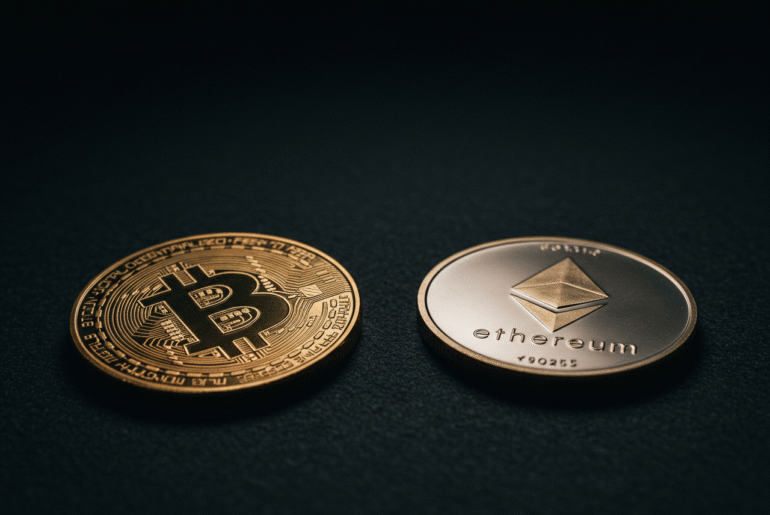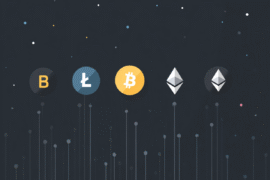This article may contain references to products or services from one or more of our advertisers or partners. We may receive compensation when you click on links to those products or services. Nonetheless, our opinions are our own.
The information presented in this article is accurate to the best of our knowledge at the time of publication. However, information is subject to change, and no guarantees are made about the continued accuracy or completeness of this content after its publication date.
- Comparing Two Blockchain Paths
- Pi Network and Ethereum Compared as Blockchain Platforms
- Full Comparison
- Getting Started with Pi Network or Ethereum
- Real-World Use Cases and Adoption
- Community and Ecosystem Growth
- Development Progress and User Adoption Trends
- Security and Regulatory Considerations
- Final Thoughts
- Frequently Asked Questions
- Recommended Reads
Comparing Two Blockchain Paths
The cryptocurrency market is evolving quickly, bringing with it both exciting innovations and complex developments. Pi Network and Ethereum are two well-known platforms in this space, each offering distinct technological structures and user goals. Their different consensus models and user experiences attract diverse communities. By exploring both networks, individuals can determine which aligns better with their interests and needs in the cryptocurrency world.
Pi Network and Ethereum Compared as Blockchain Platforms
The growth of Pi Network and Ethereum reflects the evolution of blockchain technology. Pi Network simplifies mining by allowing users to earn tokens directly from mobile devices. Ethereum supports smart contracts and decentralized applications (dApps) that power various sectors, including finance and gaming. While Ethereum focuses on decentralized infrastructure, Pi Network emphasizes accessibility and mass adoption. Together, they demonstrate the diverse paths blockchain can take in expanding digital participation.
What Is Pi Network?
Pi Network is a mobile-first cryptocurrency project launched in 2019. It aims to create an inclusive digital currency by enabling users to mine coins with minimal energy usage and technical effort. The network encourages community participation in its ecosystem, governance, and development.
What Is Ethereum?
Ethereum, launched in 2015, introduced smart contracts that allow developers to build dApps. It has become a central platform in decentralized finance (DeFi), NFTs, and other digital asset ecosystems. Ethereum continues to evolve through its large developer community and innovations like the shift to proof-of-stake.
Full Comparison
| Feature | Pi Network | Ethereum |
|---|---|---|
| Launch Year | 2019 | 2015 |
| Primary Goal | Mobile-friendly mining and mass adoption | Decentralized applications (dApps) and smart contracts |
| Consensus Mechanism | Stellar Consensus Protocol (SCP); trust circles | Proof-of-Stake (PoS) |
| Mining Approach | Mobile mining with minimal energy | Staking-based validation |
| Smart Contract Support | Not fully implemented yet | Fully supported; thousands of dApps |
| User Accessibility | Very high – smartphone only | Moderate – requires wallet and technical know-how |
| Energy Consumption | Extremely low | Reduced after PoS transition |
| Transaction Speed | Fast (limited scope) | Variable; improving with Layer 2 |
| Transaction Costs | Nearly zero | Variable; can be high |
| Token Distribution | Mobile mining; phased mainnet release | Staking and past mining rewards |
| Mainnet Status | In transition (limited access) | Fully operational |
| Developer Ecosystem | Limited; mobile-centric | Extensive global developer base |
| Use Cases | Social mining, mobile transactions | DeFi, NFTs, enterprise, dApps |
| Community Engagement | Grassroots growth via referrals | Strong developer and investor community |
| Criticisms | Lack of transparency, unclear utility | High gas fees, congestion during peak use |
| Exchange Availability | Not publicly tradable yet | Available on all major exchanges |
| Wallet Support | Built-in app wallet | MetaMask, Ledger, Coinbase Wallet, etc. |
| KYC Requirements | Required before transfers | Typically required by exchanges |
| Token Utility | Limited; ecosystem still developing | Used for dApps, gas fees, staking |
| Environmental Impact | Minimal | Significantly reduced with PoS |
| Long-Term Investment Appeal | High potential, high risk (early stage) | Established, reliable, widely adopted |
| Security Model | Trust circles + SCP | Validator staking and smart contract audits |
Getting Started with Pi Network or Ethereum
To use either platform, users need a compatible digital wallet and must complete Know Your Customer (KYC) verification. Pi requires its official mobile app for mining and onboarding, while Ethereum wallets like MetaMask or Ledger allow access to its ecosystem. A basic understanding of blockchain concepts helps users engage more confidently.
Voted "Best Overall Budgeting App" by Forbes and WSJ
Monarch Money helps you budget, track spending, set goals, and plan your financial future—all in one app.
Get 50% OFF your first year with code MONARCHVIP
Real-World Use Cases and Adoption
Pi Network focuses on financial inclusion by offering easy access to cryptocurrency through mobile mining. Ethereum powers a broad range of dApps, including lending, NFT marketplaces, and enterprise solutions. Each demonstrates how blockchain can serve distinct real-world needs.
Community and Ecosystem Growth
Pi Network grows through grassroots user participation and social referrals. Ethereum, on the other hand, benefits from extensive collaborations with developers and enterprises. Both platforms rely on community engagement to drive innovation and long-term sustainability.
Development Progress and User Adoption Trends
Pi Network is progressing toward a full mainnet launch with enhanced features and KYC expansion. Ethereum continues to lead with real-world applications and innovations in DeFi, NFTs, and staking. Both attract attention from users and investors interested in the future of blockchain.
Security and Regulatory Considerations
Pi Network faces scrutiny for its centralization and lack of clarity around its long-term roadmap. Ethereum, while decentralized, has dealt with criticisms around network congestion and gas fees. Both platforms operate under increasing regulatory observation, which may affect their evolution.
Final Thoughts
Pi Network and Ethereum highlight different approaches to blockchain. Ethereum is established, with broad functionality and global adoption. Pi Network is still emerging, focused on usability and inclusivity. Choosing between them depends on individual goals, risk tolerance, and technical interests. As blockchain grows, these platforms illustrate the spectrum of possibilities in the decentralized digital economy.
Frequently Asked Questions
How is decentralization different between Pi Network and Ethereum?
Pi Network promotes decentralization through mobile access and trust circles, lowering participation barriers. Ethereum offers a more robust decentralized infrastructure, supporting complex applications and validator-based governance. This gives Ethereum a more scalable and permissionless architecture. Pi focuses more on user onboarding simplicity and controlled growth during its early stages.
Can you exchange Pi for Ethereum or other cryptocurrencies?
Currently, no. Pi is not yet listed on exchanges. Users must wait until the mainnet fully launches and trading is permitted. Until then, Pi coins remain within the ecosystem and cannot be traded on traditional or decentralized exchanges. Always monitor official channels for updates on listings and exchangeability.
What criticisms does Pi Network face?
Critics cite concerns about transparency, delays, data collection, and lack of real token utility. Its centralized development approach and unclear timeline also raise skepticism. Additionally, its referral model has drawn comparisons to multi-level marketing, though the team insists it is designed to build trust. These factors contribute to ongoing debates about its legitimacy and long-term value.
Which is better for long-term investment: Pi or Ethereum?
Ethereum is a mature, proven platform with extensive use cases. Pi carries more risk due to its early stage but may appeal to users seeking accessibility and long-term growth. Ethereum has greater institutional adoption, developer activity, and real-world integration. Investors should weigh their goals and risk tolerance carefully before making decisions.

Reviewed and edited by Albert Fang.
See a typo or want to suggest an edit/revision to the content? Use the contact us form to provide feedback.
At FangWallet, we value editorial integrity and open collaboration in curating quality content for readers to enjoy. Much appreciated for the assist.
Did you like our article and find it insightful? We encourage sharing the article link with family and friends to benefit as well - better yet, sharing on social media. Thank you for the support! 🍉
Article Title: Pi Network vs Ethereum: Comparing Blockchain Models and Real-World Use
https://fangwallet.com/2025/08/09/pi-network-vs-ethereum-comparing-blockchain-models-and-real-world-use/The FangWallet Promise
FangWallet is an editorially independent resource - founded on breaking down challenging financial concepts for anyone to understand since 2014. While we adhere to editorial integrity, note that this post may contain references to products from our partners.
The FangWallet promise is always to have your best interest in mind and be transparent and honest about the financial picture.
Become an Insider

Subscribe to get a free daily budget planner printable to help get your money on track!
Make passive money the right way. No spam.
Editorial Disclaimer: The editorial content on this page is not provided by any of the companies mentioned. The opinions expressed here are the author's alone.
The content of this website is for informational purposes only and does not represent investment advice, or an offer or solicitation to buy or sell any security, investment, or product. Investors are encouraged to do their own due diligence, and, if necessary, consult professional advising before making any investment decisions. Investing involves a high degree of risk, and financial losses may occur including the potential loss of principal.
Source Citation References:
+ Inspo
There are no additional citations or references to note for this article at this time.











































